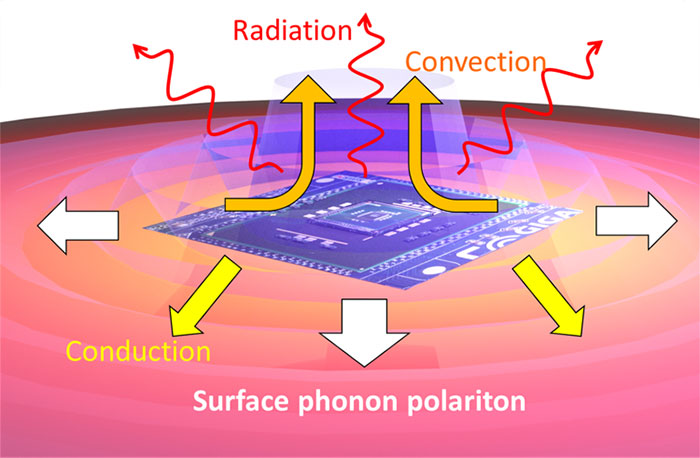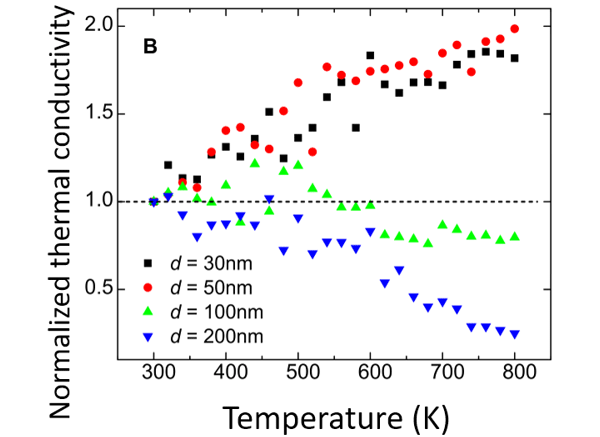Project researcher Yunhui Wu and associate professor Masahiro Nomura et. al, Institute of Industrial Science, The University of Tokyo jointly with professor Sebastian Volz of the French National Centre for Scientific Research (CNRS) successfully enhanced thermal conductivity of silicon-nitride(1) film by using surface phonon-polaritons (SPhPs)(2), which are hybrid states of light and phonons(3). Thermal conduction in solids is explained by movements of phonons, which is a carrier of heat. In a case of thin-films, scattering on the surface prevents phonon transport, causing drastically lower thermal conductivity. Thermal conductivity decreases progressively as the temperature increase. In highly integrated and miniaturized semiconductor devices, a large amount of energy is injected into a small area; thus, localized heat generation often limits device performance. Therefore, there are many attempts to promote heat dissipation.
In the present study, we focused on SPhPs. In a thin-film structure with low thermal conductivity, we searched for a possibility of the 4th heat dissipation mechanism following conduction, convection, and radiation, by enhancing thermal conductivity with the use of the power of light where conduction rate is orders of magnitude faster.
When we measured thermal conductivity in silicon-nitride nano- films with different thicknesses between the room temperature to 500°C, we discovered that a film with the thickness of 100 nm experienced decrease in thermal conductivity with increasing temperature, while a film with the thickness of 50 nm or below, thermal conductivity continued to increase, doubling its value. This result indicates that in thin-films, SPhPs greatly contributes to thermal conduction, possibly becoming a heat dissipation mechanism equivalent to or better than solid heat conduction.
The present result shows a possibility of the 4th heat dissipation mechanism, following conduction, convection, and radiation, with phonons by borrowing the power of light. Alleviation of heat dissipation issues of highly integrated and miniaturized semiconductor devices is anticipated, along with applications to the field of semiconductors. By dissipating heat from the areas with notable localized heat dissipation by using SPhPs thermal conduction in addition to conduction, it could contribute to increased performance of devices.
The present result was achieved through a team project by JST Strategic Basic Research Programs (CREST).
(1)Silicon-nitride
Its high density and high dielectric constant make it an important and essential material in the silicon integrated circuit technology as a gate insulator and a protective film.
(2)Surface phonon-polaritons (SPhPs)
Phonon-polaritons are hybrid states of light and phonons. SPhPs are localized on surface of solids and thin-films. When electromagnetic waves and polarization interact, SPhPs are quasi-particles that propagate within the plane at a speed slower than the light but much faster than optical phonons.
(3)Phonon
A quasiparticle quantizing a vibration. Transmission of vibration can be viewed as movements of particles. Thermal conduction within solids is a collective transport of phonons.
-

Figure 1. Schematic of thermal diffusion channels; conduction, convection, radiation, and surface phonon polariton.
-

Figure 2. Temperature dependence of the normalized thermal conductivities of SiN membranes. Surface phonon polaritons enhances thermal conduction at higher temperature and thinner membranes.
Program Information
- JST CREST
- Research Area “Scientific Innovation for Energy Harvesting Technology”
- Research Theme “Sensing system with thermoelectric energy harvestors based on phonon engineering”
- Research Area “Creation of Innovative Core Technologies for Nano-enabled Thermal Management”
- Research Theme “Controlling Two-dimensional Surface Phonon Polariton Heat Transfer”
Journal Information
Y. Wu, J. Ordonez-Miranda, S. Gluchko, R. Anufriev, D. De Sousa Meneses, L. Del Campo, S. Volz and M. Nomura, “Enhanced thermal conduction by surface phonon-polaritons”, Science Advances. Published online September 30, 2020, doi: 10.1126/sciadv.abb4461
Contact
-
[About Research]
Masahiro Nomura
Research Center for Advanced Science and Technology, the University of Tokyo
TEL:+81-3-5452-6303
E-mail: nomuraiis.u-tokyo.ac.jp
-
[About Program]
Shimabayashi Yuko
Department of Strategic Basic Research, JST
E-mail: crestjst.go.jp
